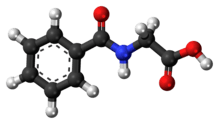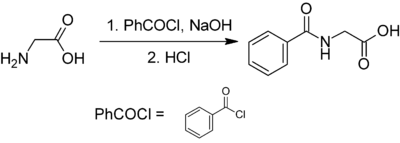Hippuric acid
Hippuric acid (Gr. hippos, horse, ouron, urine) is a carboxylic acid and organic compound. It is found in urine and is formed from the combination of benzoic acid and glycine. Levels of hippuric acid rise with the consumption of phenolic compounds (such as fruit juice, tea and wine). The phenols are first converted to benzoic acid, and then to hippuric acid and excreted in urine.[1]
 | |
 | |
| Names | |
|---|---|
| IUPAC name
Benzoylaminoethanoic acid | |
Other names
| |
| Identifiers | |
3D model (JSmol) |
|
| ChEBI | |
| ChEMBL | |
| ChemSpider | |
| ECHA InfoCard | 100.007.098 |
| KEGG | |
PubChem CID |
|
| UNII | |
CompTox Dashboard (EPA) |
|
| |
| |
| Properties | |
| C9H9NO3 | |
| Molar mass | 179.175 g·mol−1 |
| Density | 1.371 g/cm3 |
| Melting point | 187 to 188 °C (369 to 370 °F; 460 to 461 K) |
| Boiling point | 240 °C (464 °F; 513 K) (decomposes) |
| Hazards | |
| Safety data sheet | Material Safety Data Sheet |
Except where otherwise noted, data are given for materials in their standard state (at 25 °C [77 °F], 100 kPa). | |
| Infobox references | |
Hippuric acid crystallizes in rhombic prisms which are readily soluble in hot water, melt at 187 °C, and decompose at about 240 °C. High concentrations of hippuric acid may also indicate a toluene intoxication; however, scientists have called this correlation into question because there are other variables that affect levels of hippuric acid.[2] When many aromatic compounds such as benzoic acid and toluene are taken internally, they are converted to hippuric acid by reaction with the amino acid, glycine.
Synthesis
A modern synthesis of hippuric acid involves the acylation of glycine with benzoyl chloride:[3]
Biochemically, hippuric acid is produced from benzoic acid by direct glycine acylation. It is one of the two conjugates of benzoic acid produced metabolically, the other being the glucuronide. Both are eliminated from the body in urine. Benzoic acid is introduced into the body by ingestion (sodium benzoate is used as a preservative) and by hydrolysis of pharmaceutical agents such as benzyl benzoate.[4]
Reactions
Hippuric acid is readily hydrolysed by hot caustic alkalis to benzoic acid and glycine. Nitrous acid converts it into benzoyl glycolic acid, C6H5C(=O)OCH2CO2H. Its ethyl ester reacts with hydrazine to form hippuryl hydrazine, C6H5CONHCH2CONHNH2, which was used by Theodor Curtius for the preparation of hydrazoic acid.
History
Justus von Liebig showed in 1829 that hippuric acid differed from benzoic acid and he named it,[5] and in 1834 he determined its constitution,[6] while in 1853 French chemist Victor Dessaignes (1800–1885) synthesized it by the action of benzoyl chloride on the zinc salt of glycine.[7] It was also formed by heating benzoic anhydride with glycine,[8] and by heating benzamide with monochloroacetic acid.
References
- "Human Metabolome Database: Showing metabocard for Hippuric acid (HMDB0000714)". www.hmdb.ca. Retrieved 2018-09-21.
- Pero, RW (2010). "Health consequences of catabolic synthesis of hippuric acid in humans". Current Clinical Pharmacology. 5 (1): 67–73. doi:10.2174/157488410790410588. PMID 19891605.
- Ingersoll, A. W.; Babcock, S. H. (1932). "Hippuric acid". Organic Syntheses. 12: 40. doi:10.15227/orgsyn.012.0040.; Collective Volume, 2, p. 328
- Knowles, Charles O. (1991). "22.4.2 Benzyl Benzoate". In Hayes, Wayland J.; Laws, Edward R. (eds.). Handbook of Pesticide Toxicology, Volume 3: Classes of Pesticides. Academic Press. pp. 1505–1508. ISBN 9781483288635.
- Liebig, Justus (1829). "Ueber die Säure, welche in dem Harn der grasfressenden vierfüssigen Thiere enthalten ist" [On the acid which is contained in the urine of grass-eating, four-footed animals]. Annalen der Physik und Chemie (in German). 17: 389–399. Liebig named hippuric acid on p. 390: "Da ich die Säure aus dem Pferdeharn vorzugsweise untersucht habe, so werde ich sie, in Ermanglung eines passenderen Namens, mit Hippursäure bezeichnen." (Since I have especially investigated the acid from horse urine, then, for want of a more suitable name, I will designate it with [the name] "hippuric acid".)
- Liebig, Justus (1834) "Ueber die Zusammensetzung der Hippursäure" (On the composition of hippuric acid), Annalen der Physik und Chemie, 32 : 573–574.
- Dessaignes V. (1853). "Ueber die Regeneration der Hippursäure" [On the regeneration of hippuric acid]. Annalen der Chemie und Pharmacie. 87 (3): 325–327. doi:10.1002/jlac.18530870311. See also: Dessaignes (1853) "Note sur la régénération de l'acide hipparique," Comptes rendus, 37 : 251–252.
- Curtius T. (1884). "Synthese von Hippursäure und Hippursäureäthern" [Synthesis of hippuric acid and hippuric acid esters]. Berichte der Deutschen Chemischen Gesellschaft. 17 (2): 1662–1663. doi:10.1002/cber.18840170225.

